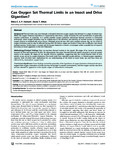Can Oxygen Set Thermal Limits in an Insect and Drive Gigantism?
| dc.contributor.author | Verberk, WCEP | |
| dc.contributor.author | Bilton, DT | |
| dc.date.accessioned | 2017-03-24T18:08:12Z | |
| dc.date.available | 2017-03-24T18:08:12Z | |
| dc.date.issued | 2011 | |
| dc.identifier.issn | 1932-6203 | |
| dc.identifier.issn | 1932-6203 | |
| dc.identifier.other | ARTN e22610 | |
| dc.identifier.uri | http://hdl.handle.net/10026.1/8688 | |
| dc.description.abstract |
BACKGROUND: Thermal limits may arise through a mismatch between oxygen supply and demand in a range of animal taxa. Whilst this oxygen limitation hypothesis is supported by data from a range of marine fish and invertebrates, its generality remains contentious. In particular, it is unclear whether oxygen limitation determines thermal extremes in tracheated arthropods, where oxygen limitation may be unlikely due to the efficiency and plasticity of tracheal systems in supplying oxygen directly to metabolically active tissues. Although terrestrial taxa with open tracheal systems may not be prone to oxygen limitation, species may be affected during other life-history stages, particularly if these rely on diffusion into closed tracheal systems. Furthermore, a central role for oxygen limitation in insects is envisaged within a parallel line of research focussing on insect gigantism in the late Palaeozoic. METHODOLOGY/PRINCIPAL FINDINGS: Here we examine thermal maxima in the aquatic life stages of an insect at normoxia, hypoxia (14 kPa) and hyperoxia (36 kPa). We demonstrate that upper thermal limits do indeed respond to external oxygen supply in the aquatic life stages of the stonefly Dinocras cephalotes, suggesting that the critical thermal limits of such aquatic larvae are set by oxygen limitation. This could result from impeded oxygen delivery, or limited oxygen regulatory capacity, both of which have implications for our understanding of the limits to insect body size and how these are influenced by atmospheric oxygen levels. CONCLUSIONS/SIGNIFICANCE: These findings extend the generality of the hypothesis of oxygen limitation of thermal tolerance, suggest that oxygen constraints on body size may be stronger in aquatic environments, and that oxygen toxicity may have actively selected for gigantism in the aquatic stages of Carboniferous arthropods. | |
| dc.format.extent | e22610-e22610 | |
| dc.format.medium | Print-Electronic | |
| dc.language | en | |
| dc.language.iso | eng | |
| dc.publisher | Public Library of Science (PLoS) | |
| dc.subject | Animals | |
| dc.subject | Body Size | |
| dc.subject | Body Temperature | |
| dc.subject | Body Weight | |
| dc.subject | Insecta | |
| dc.subject | Larva | |
| dc.subject | Oxygen | |
| dc.subject | Oxygen Consumption | |
| dc.title | Can Oxygen Set Thermal Limits in an Insect and Drive Gigantism? | |
| dc.type | journal-article | |
| dc.type | Article | |
| plymouth.author-url | https://www.ncbi.nlm.nih.gov/pubmed/21818347 | |
| plymouth.issue | 7 | |
| plymouth.volume | 6 | |
| plymouth.publication-status | Published online | |
| plymouth.journal | PLoS ONE | |
| dc.identifier.doi | 10.1371/journal.pone.0022610 | |
| plymouth.organisational-group | /Plymouth | |
| plymouth.organisational-group | /Plymouth/Faculty of Science and Engineering | |
| plymouth.organisational-group | /Plymouth/Faculty of Science and Engineering/School of Biological and Marine Sciences | |
| plymouth.organisational-group | /Plymouth/REF 2021 Researchers by UoA | |
| plymouth.organisational-group | /Plymouth/REF 2021 Researchers by UoA/UoA07 Earth Systems and Environmental Sciences | |
| plymouth.organisational-group | /Plymouth/Research Groups | |
| plymouth.organisational-group | /Plymouth/Research Groups/Marine Institute | |
| plymouth.organisational-group | /Plymouth/Users by role | |
| plymouth.organisational-group | /Plymouth/Users by role/Academics | |
| dc.publisher.place | United States | |
| dcterms.dateAccepted | 2011-07-01 | |
| dc.identifier.eissn | 1932-6203 | |
| dc.rights.embargoperiod | Not known | |
| rioxxterms.versionofrecord | 10.1371/journal.pone.0022610 | |
| rioxxterms.licenseref.uri | http://www.rioxx.net/licenses/all-rights-reserved | |
| rioxxterms.licenseref.startdate | 2011 | |
| rioxxterms.type | Journal Article/Review |


